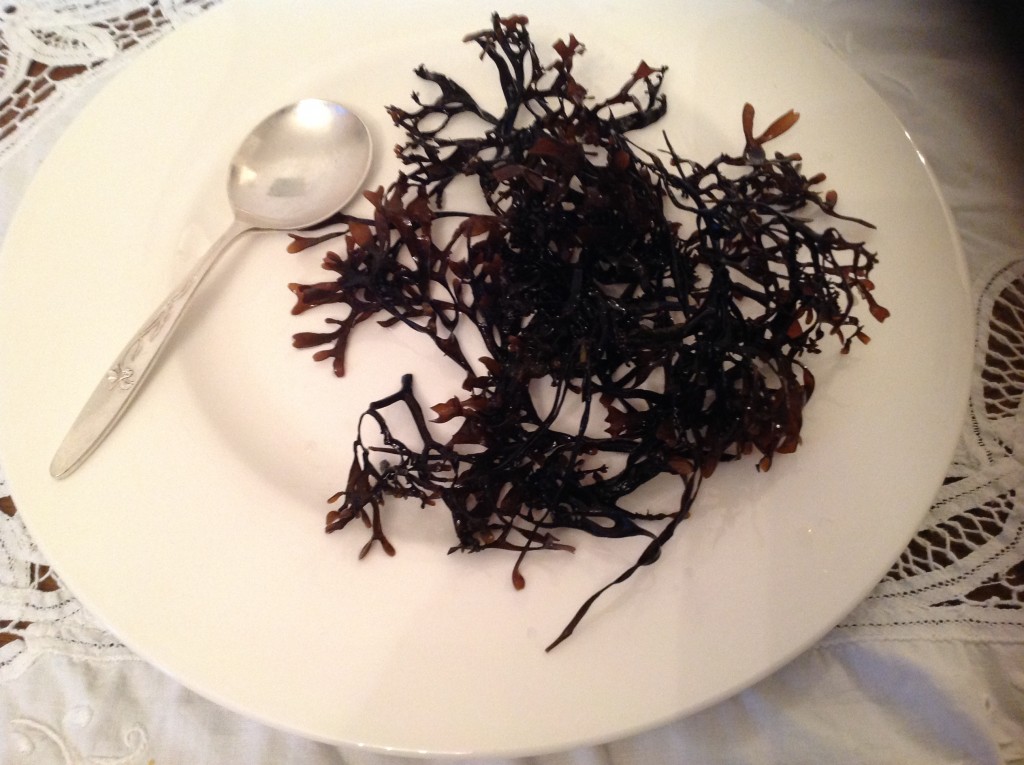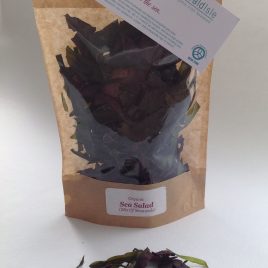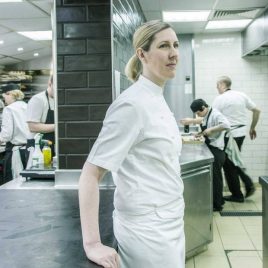Description
One bag of dry Carrageen Irish Moss, free delivery to UK.
Sun bleached: used for desserts, puddings etc
Not sun bleached: used for health in general
Chondrus Crispus — commonly called Irish moss or carrageen moss(eng) (Irish carraigín, “little rock”)
All Emerald Isle Seaweed has be tested for chemical, pesticides and water quality.
Description:
Carrageen moss (Mastocarpus stellatus or Chondrus Crispus )is a species of red algae which grows abundantly along the rocky parts of the Atlantic coast of Europe and North America. In its fresh condition this protist is soft and cartilaginous, varying in color from a greenish-yellow, through red, to a dark purple or purplish-brown. The principal constituent is a mucilaginous body, made of the polysaccharide carrageenan, which constitutes 55% of its weight. The organism also consists of nearly 10% protein and about 15% mineral matter, and is rich in iodine and sulfur. When softened in water it has a sea-like odour and because of the abundant cell wall polysaccharides it will form a jelly when boiled, containing from 20 to 100 times its weight of water.
Mastocarpus stellatus Guiry is a species which can be readily distinguished by its strongly channelled and often somewhat twisted thallus. The cystocarpic plants of Mastocarpus show reproductive papillae[clarification needed] quite distinctively different from Chondrus.[1] When washed and sun-dried for preservation, it has a yellowish, translucent, horn-like aspect and consistency.
Mastocarpus stellatus, also called Clúimhín Cait, carragheen, or false Irish moss, is a species of red algae closely related to Irish Moss, or Chondrus crispus
Distribution,
Mastocarpus stellatus or Chondrus Crispus is common all around the shores of Ireland
Mastocarpus stellatus and Chondrus Crispus is an industrial source of carrageenan, which is commonly used as a thickener and stabilizer in milk products such as ice cream and processed foods, including lunch meat. In Europe, it is indicated as E407 or E407b. It may also be used as a thickener in calico-printing and for fining beer or wine. Irish moss is frequently mixed with Mastocarpus stellatus (Gigartina mammillosa), Chondracanthus acicularis (G. acicularis) and other seaweeds with which it is associated in growth. Carrageenan and agar-agar are also used in Asia for gelatin-like desserts, such as almond jelly. Presently, the major source of carrageenan is tropical seaweeds of the genera Kappaphycus and Eucheuma.
In parts of Scotland (where it is known as (An) Cairgean in Scottish Gaelic) and Ireland, it is boiled in milk and strained, before sugar and other flavourings such as vanilla, cinnamon, brandy or whisky are added. The end-product is a kind of jelly similar to pannacotta, tapioca, or blancmange. Similarly, in Jamaica and Trinidad and Tobago Gracilaria spp is boiled with cinnamon and milk to make a thick drink called Irish Moss that is believed to be an aphrodisiac. In Ireland it has been used for generations as a home remedy for sore throat and chest congestion, boiled in milk and served with honey before bed.
Irish moss is commonly used as a clarifying agent in the process of brewing (beer), particularly in home brewing. A small amount is boiled with the wort, attracting proteins and other solids, which is then removed from the mixture after cooling.
Commercial use: Irish Moss has been used in Ireland since the beginning of the 19th century as a folk remedy for respiratory ailments. During the famine in Ireland emigrates exported the Irish moss to New England in the USA where it was used for sizing ropes and cooking.
Two types of carrageen. Chondrus crispus and Mastocarpus stellatus,
Tests done by J.Collen and I.R.Davison
(1) M. stellatus is better able to tolerate reactive oxygen than C. crispus, which could partly explain the higher stress tolerance of M. stellatus.
(2) Mastocarpus stellatus scavenges reactive oxygen more efficiently than C. crispus, with higher contents of anti-oxidants and/or higher activities of reactive oxygen scavenging enzymes.
(3) Chondrus crispus, but not M. stellatus, exhibits changes in reactive oxygen metabolism with tidal height, caused by its ability to acclimatize.
Shipping:
Shipping to USA cost will be £30.00 per KG (due to the volume packaging size of Carrageen wholeleaf)






